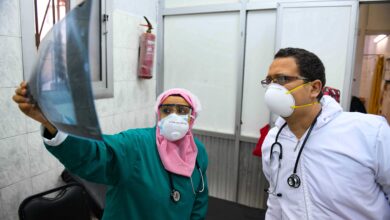
A doctor who witnessed the majority of the autopsy conducted on the body of Essam Ali Atta on Friday, 28 October said on Monday that the procedure neither confirmed nor denied whether or not the 23-year-old was tortured to death.
Ahmed Sayam, a member of the Tahrir Doctors Society, a revolutionary doctors coalition, did, however, say that the claim that water was injected into Atta's anus in the one or two days before his death cannot be true, given that his colon contained well-formed stool at the time of the autopsy.
Early reports had stated that Atta died after police officers forced water hoses into his anus and mouth.
“If he had been subject to water injections over two days, as his friends and family claim, his whole colon would have been empty,” Sayam told Al-Masry Al-Youm. “But, this does not mean it did not happen three [or more] days prior to his death.”
Sayam confirmed that foreign objects were found inside Atta’s intestines. These included two separate latex fingers from a medical glove. One of the fingers appeared to have been inserted into a round container along with six to nine encapsulated liquid pills. The liquid in the pills was red, with some seeping outside of them, Sayam said.
Also found was a rolled wrap that was between 3 to 4cm in length and .5cm in width. A statement released by the Society on 29 October said this roll contained a brown substance, resembling hashish.
Sayam refused to answer when asked how he believes these objects could have entered Atta’s body. He only said that there was no evidence on Atta’s body from what he saw at the autopsy of forced entry, internally or externally.
For many activists and lawyers, the alleged presence of drugs in Atta’s body brings back memories of the initial autopsy report of Khaled Saeed. It was said then that a rolled wrap of marijuana was found in his body, suggesting that he died from choking on the drugs, rather than police brutality.
The young Alexandrian man was tortured to death by two policemen in July 2010 in unclear circumstances. The two policemen involved were sentenced to seven years imprisonment each last week.
The cause of Atta’s death is similarly murky.
According to the poison unit of Qasr al-Aini hospital, Atta died of poisoning. The unit has also said it found traces of the pain reliever tramadol and hashish in Atta’s blood.
“This does not mean tramadol or hashish caused his death,” Magdy Samdy, also of the Tahrir Doctors Society, said.
Atta’s body was taken to the poison unit on Thursday, 27 October, where he died shortly after arriving.
Two plausible scenarios have emerged in the last few days from the testimonies of prison inmates and a doctor from the prison hospital over what led to Atta’s need for medical treatment, Sayed Fathy, a lawyer working on the case from the Hilal Association for Freedom, told Al-Masry Al-Youm.
According to testimonies taken on Saturday, 29 October, Atta complained to inmates that he had eaten bad food after his mother’s visit on Wednesday, 26 October. He then went to the prison hospital and came back feeling better, but his health soon deteriorated again.
Fellow inmates also said that Atta admitted to taking narcotic pills. When his health became worse again, he was taken to the Qasr al-Aini hospital.
This differs from what his family and friends said at the time of Atta’s death. They claimed that he had called them on Wednesday evening to say that he was being tortured through the insertion of water hoses containing an unknown chemical substance in his mouth and anus.
Because of these conflicting reports, Fathy has asked the public prosecutor, Abdel Meguid Mahmoud, for another autopsy to be conducted in the presence of an independent doctor.
The original autopsy was conducted by Souad Abdel Ghafar, with Sayam of the Tahrir Doctors Society acting as an independent witness. He had not planned on being an independent witness, he said, but became involved in the affair simply through being present outside the autopsy room at the time.
Sayam said the autopsy had already begun before he went into the room, with incisions being made on the right side of Atta’s forehead, the back of his head and the upper part of his back.
“It would not have been possible to insert anything into Atta’s body through these incisions,” Sayam told Al-Masry Al-Youm, dismissing any potential claims that foreign objects were slipped in during this autopsy. He did not seem be concerned with any potential foul play in the portion of the autopsy he missed.
Sayam’s statements Monday seemed to suggest that the Tahrir Doctors Society’s view on whether or not Atta was tortured has still not been decided.
Yet the society signed a statement on Monday, 31 October, alongside the Egyptian Initiative for Personal Rights (EIPR) and Al-Nadeem Center for Rehabilitation of Victims of Violence, placing the blame for Atta’s death on Interior Minister Mansour al-Essawy and Assistant Interior Minister for Prisons Mohamed Naguib.
The statement said the circumstances surrounding Atta’s death gave the organizations strong suspicion to suggest he was tortured. It calls for an immediate investigation to determine what exactly happened, and the role of the police officer, Nour Hassan, who Atta is alleged to have said was torturing him.
The final autopsy report conducted on Friday, 28 October has yet to be released. The joint statement calls for the formation of a council made up of three doctors with expertise in conducting autopsies to perform a new autopsy on Atta’s body and determine the cause of his death.
Either way, the statement, which was published on EIPR’s website, says this does not acquit the Interior Ministry from responsibility for Atta’s death.
The statement also calls for allowing human rights and civil society organizations to be allowed to visit prisons and prison hospitals to ensure they are abiding by Egyptian laws and international standards.




